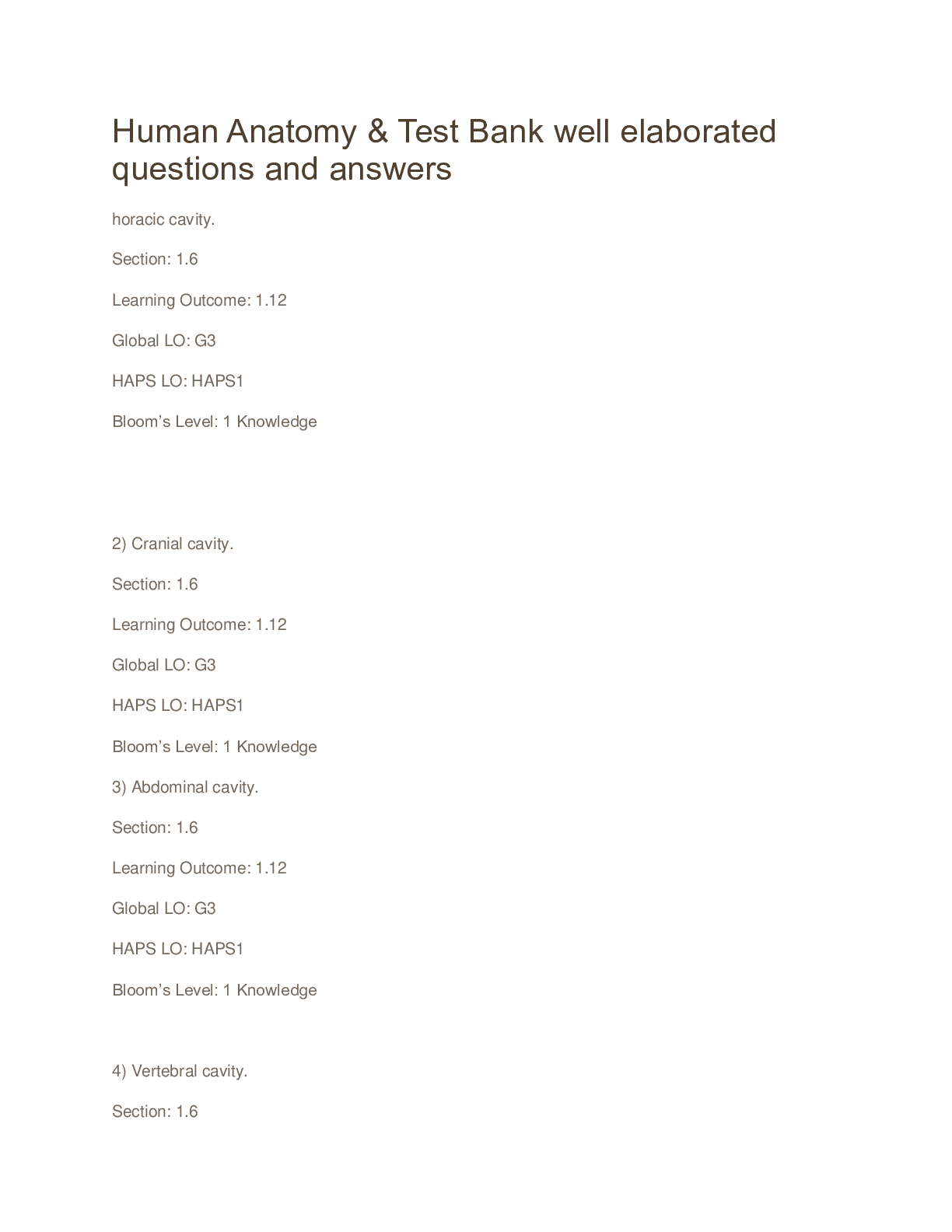*NURSING > TEST BANKS > Test Bank for Anthropology of Religion, Magic, and Witchcraft, The, 3E 3rd Edition (All)
Test Bank for Anthropology of Religion, Magic, and Witchcraft, The, 3E 3rd Edition
Document Content and Description Below
LEARNING OBJECTIVES After reading Chapter 2, the student should be able to: 1. Describe the anthropological meaning of culture and its complexities. 2. Explain why it is usually mistaken to equate ... “culture” with “nation” or “society.” 3. Discuss the nonobvious components of cultural knowledge and their importance. 4. Evaluate the importance of culture to human life. KEY TERMS culture (22) cultural identity (23) subculture (23) enculturation (socialization) (24) patterns of behavior (26) role (27) 18 The Anthropology of Religion, Magic, and Witchcraft norm (27) values (28) symbol (30) cultural construction (31) world view (34) CHAPTER SUMMARY Anthropologists use the concept of culture to understand the diversity of human experience. Culture is the shared, socially learned knowledge and patterns of behavior that are unique to a group of people. Culture is not only essential for humanity, but it is also the key to our successful adaptation in a wide variety of environments. Though definitions vary widely, anthropologists generally agree on certain characteristics of culture: it is learned, shared, has a profound impact on the group of people who share it, and is central to understanding the different ways in which groups of people act, think, and feel. In a narrow sense, culture can be defined as a mental phenomenon; material artifacts and behaviors, for example, are products of culture in this sense. Broadly defined, culture refers to the way of life of a given group of people and explains the distinctiveness of the group. Culture is shared by definition, and always socially learned. Biological differences do not explain cultural differences; they are independent of each other. Culture is passed from one generation to the next, and transmitted from place to place at any given time. Attitudes, beliefs, assumptions about the world and other socially learned information that is stored in the mind, is called cultural knowledge. The five components of cultural knowledge are: norms, values, symbols, constructions of reality (including the natural and social worlds), and world views through which reality is interpreted. Culture knowledge is learned through enculturation. It is necessary for human existence because it enables us to adapt to our environments and provides the basis for human life, as well as shaping our view of reality. LECTURE OUTLINE CULTURE I. A Definition of Culture a. Culture is both a concept and a word. b. The modern idea of culture developed in the nineteenth century. c. All human groups possess culture to the same degree. d. Anthropological definitions of culture share certain features. i. Culture is learned from other people while growing up in a particular society or group. ii. Culture is widely shared by the members of that society or group. 19 Chapter 2: Mythology iii. Culture profoundly affects the thoughts, actions, and feelings of people. iv. Culture in large part accounts for differences in how people act, think, and feel. e. Narrow concepts of culture see it as an ideational or mental phenomenon. f. Broad concepts of culture see it as the whole way of life of a group of people. g. Even within a culture, behavior varies between individuals. h. Culture is collective. i. Common cultural identities do not necessarily equate to sameness. ii. Colonialism has produced countries filled with many cultural groups who share a common cultural identity in addition to identifying other cultural affiliations. iii. Subcultures refer to nations whose citizens and residents are culturally diverse. i. Culture is socially learned. j. Enculturation is the process by which infants and children socially learn the culture of those around them. k. Culture is not transmitted through genetics or by biological reproduction. l. Any human infant is perfectly capable of learning culture of any human group or biological population. i. The same is true of language acquisition. ii. Cultural and biological differences are largely independent. m. Culture is socially learned through observation, imitation, communication, and inference. i. Every people and nation has adopted things from others. II. Cultural knowledge a. Patterns of behavior promote commonality. i. Roles are associated with privileges and obligations. ii. Norms are associated with shared ideas and expectations of how people ought to act in a given situation. b. Cultural Values c. These are people’s beliefs about the goals or ways of living that are deemed desirable. III. Cultural symbols may be objects or behaviors or events. a. These are learned along with other attributes of culture. i. Arbitrary symbols have no inherent quality. 1. A wink in one culture may have no meaning in another. ii. Conventional symbols have meaning only because people agree they do. 1. A red light at an intersection means stop only because people obey. b. Cultural constructions of reality i. Cultural knowledge that includes shared ways of perceiving the world. 1. There are constructions regarding the natural world. 2. There are constructions about social reality. 20 The Anthropology of Religion, Magic, and Witchcraft c. Cultural world views i. A world view is the way a people interpret reality and events, including their images of themselves and how they relate to the world around them. 1. Some cultures believe in things that others do not. 2. Most world views make a connection between the “natural” and “supernatural.” 3. The way people view their place in nature is part of their world view. IV. Culture, Biology, and Human Life a. Culture is necessary for human existence in at least three specific ways. i. One, culture provides the knowledge we need to adapt to our surroundings. ii. Two, culture is the basis for human social life. iii. Three, culture profoundly influences our views of reality. SUGGESTED SUPPLEMENTARY LECTURES Culture and Hominids Discuss how definitions of culture might or might not apply to other hominid species. Consider the consequences of assuming only modern humans have culture and culture only exists in modern humans on Homo erectus or Australopithecus afarensis and others. Discuss the possibility culture arose suddenly in one species or that various components of culture arose at different times throughout prehistory. Culture and Nonhuman Primates Discuss the cognitive capacities of monkeys and apes. Potato washing behavior in Japanese monkeys is a famous example of social learning still debated. Chimpanzee mothers may exhibit teaching their infants the correct technique for cracking open palm nuts with stone hammers. Students are often amazed by the ability of chimpanzees to use symbols and other properties of language. Detail the experiments done with Kanzi, the bonobo chimpanzee. One point to make is how the results of similarities between chimpanzee or non-human primate “culture” and human culture should not be too surprising, given the close degree of shared genetic material between chimpanzees and humans. The Importance of Culture Discuss the effects of symbolic thought in humans. For example, consider how symbolic thought helps us adapt to the environment. Since it is often stated that human cultural transmission of adaptations occurs at a faster rate than genetic adaptations, explain the implications that human culture transcends biological heritage. Consider if symbolic thought has reduced human biological diversity. Illustrate how the human global distribution is unusual among animals and yet we belong to a single species. 21 Chapter 2: Mythology Meaning Behind Behavior Cross-cultural misunderstandings can occur if individuals assume that any given behavior has the same meaning universally. Provide examples of similar behaviors that might have different meanings. One example is an affectionate pat on the head of an American child is received as disgusting by a Balinese child. Another facet to explore is how different behaviors can have similar meanings, such as different ways to show respect. An example of this would be assuming a sitting position in the presence of an African emir, but standing in the presence of the President of the United States. The Importance of Symbols Most anthropologists agree that the human capacity to symbolize and attach arbitrary meanings to objects, events, and so forth is what makes culture possible. Devote part of a lecture to how the culture that humans learn, share, and experience, actually relies on the ability to understand and interpret the world using symbols whose meanings are socially created and learned. Provide some examples of verbal, graphic, and behavioral symbols. Engage students by encouraging them to suggest some of their own. MEDIA SUGGESTIONS Characteristics of Culture, Lesson 2 of the series, Our Diverse World (2:36 minutes, 2008), streamed through Coast Learning Systems. This segment uses the city of Oaxaca, Mexico, to explore the nature of culture and how cultures are studied. In addition to visually defining the characteristics of culture, this segment explores how culture changes in response to outside forces. A bio-cultural approach is also explained. Full length version available with purchase. http://www.coastlearning.org/course-catalog/alphabetical-order/30-cultural-anthropologyour-diverse-world.html Culture Shock (3:53 minutes, 2008), streamed from COAST. Somali immigrants create new lives in America but encounter challenges in language and employment, placing additional strain on local community resources. http://college.cengage.com/anthropology/shared/videos/video23.html Defining Race, American in Black and White, Part 1 (7:17 minutes, 2003) and Part 2 (5:11 minutes, 2003), streamed from COAST, courtesy of ABC News. The use of genetic testing to evaluate cultural affiliation creates challenges in identity. http://college.- cengage.com/anthropology/shared/videos/video24.html Dead Birds (83 minutes, 1963) preview available through Documentary Educational Resources. This classic ethnographic film depicts the life of the Dugum Dani of New Guinea prior to extensive contact with the industrialized world. The practices of Dani warfare and magic are featured. Available for purchase. http://www.der.org/films/dead-birds.html 22 The Anthropology of Religion, Magic, and Witchcraft Holy Ghost People (53 minutes, 1967) An ethnographic film depicting a small sect of Pentecostal Christians in Scrabble Creek, West Virginia, who practice snake handling. This classic ethnographic documentary was made by Peter Adair and may be downloaded from the feature films section of the Internet Archive. www.archive.org STUDENT ACTIVITIES AND ASSIGNMENTS DISCUSSION QUESTIONS A Definition of Culture One way to assist students in understanding collective meaning is to ask them what people might mean when they wink. Consider re-reading Geertz’s “Thick Descriptions” in The Interpretation of Cultures for inspiration. Ask students to explain how they “know” the different meanings and how they think they learned them. Detail a misinterpreted wink and share examples of the meanings of winks in other cultures. Cultural Knowledge Ask students to make a list of personal values and a separate list detailing the values of other Americans. Have the class reflect on any differences between the two lists. Identify the amount of discrepancy and discuss what it means to claim values that are shared. If there are international students present, compare their lists to the others. Discuss any discrepancies and evaluate conclusions about how other peoples perceive Americans. Discuss similarities and consider if there are any universally human values. Ask students to provide examples of norms that are commonly violated and of situations in which the behavioral expectations of one norm conflicts with those of another. Bring conceptions of norms as a constraint on behavior into the discussion [Show More]
Last updated: 2 years ago
Preview 1 out of 110 pages
_repaired (1).png)
Buy this document to get the full access instantly
Instant Download Access after purchase
Buy NowInstant download
We Accept:

Reviews( 0 )
$10.00
Can't find what you want? Try our AI powered Search
Document information
Connected school, study & course
About the document
Uploaded On
Oct 26, 2021
Number of pages
110
Written in
Additional information
This document has been written for:
Uploaded
Oct 26, 2021
Downloads
0
Views
119


.png)








.png)


